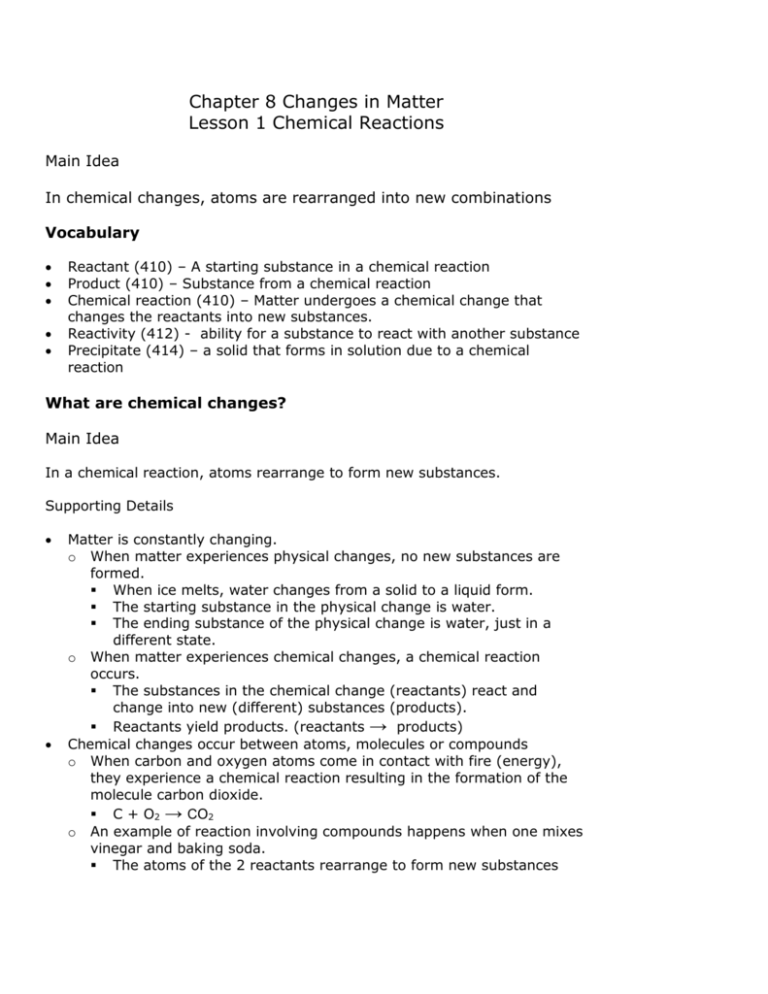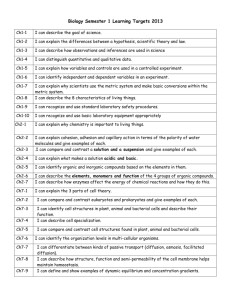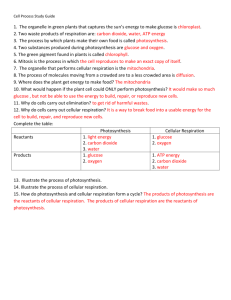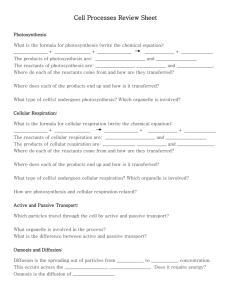8.1 Chemical Reactions
advertisement

Chapter 8 Changes in Matter Lesson 1 Chemical Reactions Main Idea In chemical changes, atoms are rearranged into new combinations Vocabulary Reactant (410) – A starting substance in a chemical reaction Product (410) – Substance from a chemical reaction Chemical reaction (410) – Matter undergoes a chemical change that changes the reactants into new substances. Reactivity (412) - ability for a substance to react with another substance Precipitate (414) – a solid that forms in solution due to a chemical reaction What are chemical changes? Main Idea In a chemical reaction, atoms rearrange to form new substances. Supporting Details Matter is constantly changing. o When matter experiences physical changes, no new substances are formed. When ice melts, water changes from a solid to a liquid form. The starting substance in the physical change is water. The ending substance of the physical change is water, just in a different state. o When matter experiences chemical changes, a chemical reaction occurs. The substances in the chemical change (reactants) react and change into new (different) substances (products). Reactants yield products. (reactants → products) Chemical changes occur between atoms, molecules or compounds o When carbon and oxygen atoms come in contact with fire (energy), they experience a chemical reaction resulting in the formation of the molecule carbon dioxide. C + O2 → CO2 o An example of reaction involving compounds happens when one mixes vinegar and baking soda. The atoms of the 2 reactants rearrange to form new substances Baking soda (sodium bicarbonate) + vinegar (acetic acid) react to form molecules of water, carbon dioxide, and sodium acetate Chemical formula: NaHCO3 + HC2H3O2 → H2O + CO2 + NaC2H3O2 The total mass of the products equals the total mass of the reactants. o The total number of atoms of each element does not change. o The atoms rearrange into new combinations. o Photosynthesis is a type of chemical reaction. o Law of Conservation of Matter: Matter can not be created or destroyed. The atoms simply rearrange themselves into new combinations What are the most reactive elements? Main Idea The most reactive metals are the alkali metals, and the most reactive nonmetals are the halogens. Supporting Details Some metallic elements are more likely to be involved in chemical reactions than other similar elements. Elements with high reactivity react easily. Alkali metals are the most reactive family of metals. o The alkali metals are Lithium (Li, 3), Sodium (Na, 11), Potassium (K, 19), Rubidium (Rb, 37), Cesium (Cs, 55), and Francium (Fr, 87). o The larger the atomic number of the alkali metals the more reactive the metal is. Francium has a higher reactivity that sodium. o You can not find reactive metals in the ground in their elemental form. They form compounds too easily. For example, sodium often combines with chlorine to form sodium chloride (table salt). Halogens are the most reactive nonmetals. o Halogens are the elements in the next to last column on the periodic table. o Halogen elements are Fluorine (Fl, 9), Chlorine (Cl, 17), Bromine (Br, 35), Iodine (I, 53), and Astatine (At, 85). o Unlike the alkali metals, the smaller the atomic number of a halogen the more reactive the element. Oxygen is another fairly reactive nonmetal. o Many metals react with oxygen to form an oxide compound. o Iron rusts when it comes in contact with air, gradually ruining the metal. o Aluminum and magnesium also react with oxygen, but the results help protect the metal. What are signs of a chemical reaction? Main idea The signs of a chemical change include formation of a precipitate or a gas, the release of energy, and a color change. Supporting Details A chemical reaction has occurred when: o A precipitate (solid compound) is formed when two solutions are combined. o A gas is produced upon the mixing of two compounds (eg., alka seltzer dissolving in water) o Temperature increase (or decrease) or the presence of light indicate the release of energy from a chemical change. Chemicals in a sealed bag release heat or cold when mixed together. The flame of a candle melts the wax, then turn it to a gas which ignites the flame. o Color change can indicate a chemical reaction. Bleach takes away the color of an item by chemically changing the molecules of the dye. Metals change color (tarnish) when they are involved What are photosynthesis and respiration? Main Ideas Plants use water, carbon dioxide, and sun’s energy in the photosynthesis process to make glucose. Plants and animals use glucose and oxygen in cellular respiration process to generate energy needed for cellular operations. Supporting Details Photosynthesis o Plants uses the energy from sunlight to rearrange the elements in carbon dioxide (from the air) and water (brought up from the roots) resulting in glucose and oxygen o Carbon dioxide and water are the reactants in the photosynthesis process. o Glucose and oxygen are the products of photosynthesis. The plant stores the glucose for later use. The plant releases the oxygen into the air. o Chemical formula for photosynthesis 6CO2 + 6H2O + sun’s energy → C6H12O6 (glucose) + 6O2 Cellular Respiration The cells in plants and animals rearrange the elements in glucose (food) and oxygen (air) in the cellular respiration process to generate energy for cell operations. o The reactants in cellular respiration are glucose and oxygen. o The products in cellular respiration are carbon dioxide and water. o Chemical formula for cellular respiration C6H12O6 (glucose) + 6O2 → Energy + 6CO2 + 6H2O Closer Look At Photosynthesis and Cellular Respiration o The products of photosynthesis are the reactants of cellular respiration. o The products of cellular respiration are the reactants of photosynthesis. o







